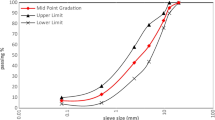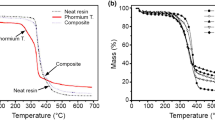Abstract
Modification of asphalt binder is a must to enhance the performance of asphalt binder. The objectives of this study are to develop an extensional deformation test method using a Sentmanat Extensional Rheometer (SER) fixture inside a Dynamic Shear Rheometer (DSR) and to investigate the relationship between different percentages of latex polymer and force ductility in polymer (latex) modified asphalt emulsion (PMAE) and polymer modified asphalt binder (PMAB). The sample geometry used in this study is 3 mm × 0.72 mm. Total twenty-four samples are tested by the SER where twelve samples are PMAE and twelve samples are PMAB. One neat binder PG 64-22 and one PMAE are used. 2%, 4% and 6% latex are mixed with PG 64-22 by a mechanical mixer and a high shear mixer for making PMAB. PMAEs are collected from the manufacture with 0%, 2.5%, 4% and 5.5% latex in it. Second peak elongation force, F2 is only obtained from the latex modified binders and emulsions. First peak elongation force, F1 has no linear correlation in case of PMAE and PMAB where F2 has a linear correlation with the percent of the polymer in the PMAE and PMAB with R2 values equal to 0.9934 and 0.9535 respectively indicating extensional deformation test with SER is very promising. Additionally, DSR temperature sweep test results and multiple stress creep recovery (MSCR) test results indicate that F2 is a better indicator of polymer content than rutting factor G*/sinδ and non-recoverable creep compliance, Jnr.
Similar content being viewed by others
References
G. R. Morrison, J. K. Lee, S. A. M. Hesp, Chlorinated polyolefins for asphalt binder modification, J. Appl. Polym. Sci. 54 (2) (1994) 231–240.
X. Lu, U. Isacsson, Modification of road bitumens with thermoplastic polymers, Polym. Test. 20 (1) (2001) 77–86.
J. B. Johnston, G. N. King, Using Polymer Modified Asphalt Emulsions in Surface Treatments — A Federal Lands Highway Interim Report, Federal Highway Administration, New Jersey Avenue, Washington DC, USA, 2008.
R.F.A. Altman, Organic analysis of hevea latex. IX. details of the main fractions, Rubb. Chem. Technol. 20 (1947) 1133–1139.
S. Labi, G. Lamptey, S. H. Kong, Effectiveness of Microsurfacing Treatments, J. Transp. Eng. 133 (5) (2007) 298–307.
S. Labi, K. C. Sinha, Life-Cycle Evaluation of Flexible Pavement Preventive Maintenance, J. Transp. Eng. 131 (10) (2005) 744–751.
T. C. Erwin, Safety Effects of Preventive Maintenance Microsurfacing- A Case Study, (M.S. Thesis), University of Waterloo, Waterloo, Ontario, Canada, 2007.
A. Forbes, R. G. Haverkamp, T. Robertson, S. Bearsley, Studies of the Microstructure of Polymer-Modified Bitumen Emulsions Using Confocal Laser Scanning Microscopy, J. Microsc. 204 (3) (2001) 252–257.
K. Takamuraa, W. Heckman, Polymer Network Formation in the Pavement Using SBR Latex Modified Asphalt Emulsions, Stud. Surf. Sci. Catal. 132 (2001) 271–274.
M. A. Shafii, J. Ahmed, E. Shafiie, Physical properties of asphalt emulsion modified with natural rubber latex, World J. Eng. 10 (2) (2013) 159–164.
Y. Chen, G. Tebaldi, R. Roque, G. Lopp, Effects of Polymer Modified Asphalt Emulsion (PMAE) on Pavement Reflective Cracking Performance, 7th RILEM International Conference on cracking in Pavements, Delft, the Netherlands, 4, 2012, pp. 879–888.
Q. Zhang, W. Fan, T. Wang, G. Nan, Studies on the temperature performance of SBR modified asphalt emulsion, International Conference on Electric Technology and Civil Engineering (ICETCE), China, 2011, pp.730–733.
H. Siswanto, The effect of latex on permanent deformation of asphalt concrete wearing course, Proc. Eng. 171 (2017) 1390–1394.
C. S. Ruggles, The efficient use of environmentally-friendly natural rubber latex in road construction- past, present and the future, Seminar rubber in transport. Breda, The Netherlands, 2004.
American Association of State Highway and Transportation Officials, Standard Method of Test for Force Ductility Test of Bituminous Materials. AASHTO T300-11, AASHTO, Washington DC, USA, 2016.
M. L. Sentmanat, Miniature universal platform: from extensional melt rheology to solid state deformation behavior, Rheologica Acta 43 (6) (2004) 657The Netherlands669.
M. L. Sentmant, Extensional Rheology: An Invaluable Tool for Material Characterization, Xpansion Instrument, LLC, Spicewood, TX, USA, 2012.
W. B. O. Mohammed, N. M. Wasiuddin, Development of a Novel and DSR Based Extensional Deformation Test Replacing Force Ductility Test (AASHTO 300), Presentation on TRB’s 97th Annual Meeting, Washington DC, USA, 2018.
American Society for Testing and Materials, Standard Test Method for Residue by Evaporation of Emulsified Asphalt. ASTM D6934-08. ASTM International, West Conshohocken, PA, 2016.
American Association of State Highway and Transportation Officials, Standard Method of Test for Determining the Rheological Properties of Asphalt Binder Using a Dynamic Shear Rheometer (DSR). AASHTO T315-11. AASHTO, Washington DC, USA, 2012.
American Association of State Highway and Transportation Officials, Standard Method of Test for Multiple Stress Creep Recovery (MSCR) Test of Asphalt Binder Using a Dynamic Shear Rheometer (DSR). AASHTO T350-11. AASHTO, Washington DC, USA, 2014.
E. Shaffie, J. Ahmad, A. K. Arshada, D. Kamarund, H. Awanga, Investigation on rutting performance of nanopolyacrylate and natural rubber latex polymer modified asphalt binder mixes, Jurnal Teknologi (Sci. Eng.) 78 (7-3) (2016) 11–15.
W. Saowapark, C. Jubsilp, S. Rimdusit, Natural rubber latex-modified asphalts for pavement application: effects of phosphoric acid and sulphur addition, Road Mater. Pave. Des. 20 (1) (2019) 211–224.
S. A. Tabatabaei, A. Kiasat F. K. Alkouhi, The Effect of Styrene-Butadiene-Rubber (SBR) Polymer Modifier on Properties of Bitumen, International J. Mater. Metallurgical Eng. 7 (10) (2013) 785–788.
F. J. Navarro, P. Partal, F. M-Boza, C. Gallegos, Influence of crumb rubber concentration on the rheological behavior of a crumb rubber modified bitumen, Energy Fuels 19 (5) (2005) 1984–1990.
H. Al-Abdul-Wahhab, G. Al-Amri, Laboratory evaluation of reclaimed rubber asphaltic concrete mixes, J. Mater. Civ. Eng. 3 (3) (1991) 189–203.
A. H. Albayati, H. K. Mohammed, Influence of styrene butadiene rubber on the mechanical properties of asphalt concrete mixtures, Al-Qadisiyah J. Eng. Sci. 4 (3) (2011) 258–274.
A. Khadivar, A. Kavussi, Rheological characteristics of SBR and NR polymer modified bitumen emulsions at average pavement temperatures, Constr. Buil. Mater. 47 (2013) 1099–1105.
A. A. Tamimi, I. A. H. A. Zubaidy, A. Upadhye, L. Ali, Evaluation of sustainable asphalt mixture, Study Civ. Eng. Archit. 3 (2014) 41–47.
J. C. Chen, M. C. Lio, M. S. Shian, Asphalt Modified by Styrene-Butadiene-Styrene Triblock Copolymer: Morphology and Model, J. Mater. Civ. Eng. 14 (3) (2002) 224–229.
P. Shirodkar, Y. Mehta, A. Nolan, K. Dahm, R. Dusseau, L. McCarthy, Characterization of creep and recovery curve of polymer modified binder, Constr. Buil. Mater. 34 (2012) 504–511.
Acknowledgement
This study is funded by the Transportation Consortium of South-Central States (Tran-SET) under the project “Development of a Standard Test Method for Characterization of Asphalt Modifiers and Aging-Related Degradation Using an Extensional Rheometer”.
Author information
Authors and Affiliations
Corresponding author
Additional information
Revised version of a paper presented at 15th World Conference on Transport Research (WCTR), Bombay, Mumbai, India, 26–31 May 2019.
Rights and permissions
About this article
Cite this article
Hossain, R., Wasiuddin, N.M. A Novel Method for Polymer Content Determination in Asphalt Binder and Emulsion. Int. J. Pavement Res. Technol. 12, 604–612 (2019). https://doi.org/10.1007/s42947-019-0072-6
Received:
Revised:
Accepted:
Published:
Issue Date:
DOI: https://doi.org/10.1007/s42947-019-0072-6




